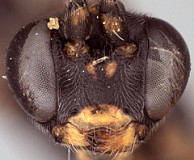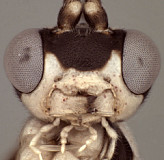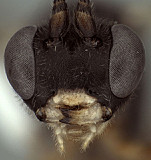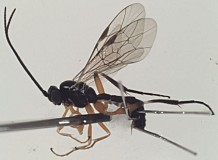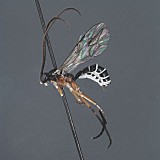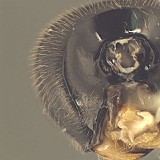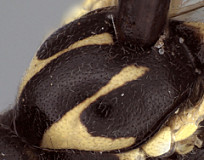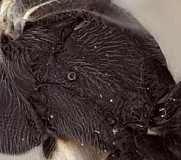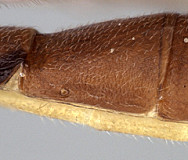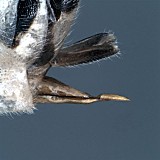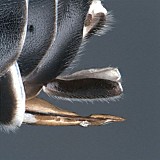Clypeus (Fig. 4) variable but usually narrow, often tall; either flat, weakly concave medially, or strongly bulging medially and subapically; ventral margin sharp throughout, though sharp margin partially overlapped by blunt median bulge in a few species; ventral margin sometimes truncate medially but often weakly (Fig. 4) to strongly bilobed, with sharp lateral margins distinctly angled dorsally; epistomal sulcus varying from sharp and distinct to shallow and indistinct. Malar space in species examined equal to or shorter than half basal width of mandible (Fig. 4). Mandible (Fig. 4) varying from relatively short and broad to moderately long in material examined; curved,sometimes strongly so; either gradually narrowing from base to apex or more or less parallel-sided over apical half; ventral tooth varying from slightly shorter and narrower, to about equal, to slightly longer than dorsal tooth. Inner eye margins parallel to weakly converging ventrally. Ocelli variable; most commonly small, with maximum diameter of lateral ocellus distinctly shorter than distance between ocellus and eye but larger, with maximum diameter shorter than distance to eye in 10 % of species examined. Female and male antennae at least as long as body in material examined, commonly longer than body at least in females; first flagellomere long and slender in many species (nearly twice longer than second), but distinctly shorter and less than twice longer than second in several species (as in Fig. 2). Hypostomal carina joining occipital carina above base of mandible (Fig. 5); occipital carina complete. Epomia absent or pronotum laterally in some species with rugose sculpture that appears epomia-like. Dorsal end of epicnemial carina nearly always extending to anterior margin of mesopleuron but sometimes weaker dorsally and slightly separated from anterior margin in at least a few species; mesopleuron ventrally somewhat variable in sculpture from nearly smooth and polished to finely mat to more coarsely granular-mat. Notaulus varying from absent or nearly so (Fig. 6) to present and either weak or rarely sharply impressed; distinct and extending to anterior margin in about 25% of species examined. Pleural carina nearly always well-developed (Fig. 7), rarely weaker posteriorly; propodeal carinae rarely as poorly developed as in the type species of
Mesoleius with petiolar area open anteriorly and lateral longitudinal carinae short, weak; usually with well-developed lateral longitudinal carina extending nearly to anterior margin; petiolar area delimited by tall carinae and varying from small to very large; median longitudinal carinae extending from petiolar area to anterior margin with areola usually distinct and roughly triangular with median carinae then broadening anteriorly to form basal median area; transverse carinae otherwise absent; Legs with apical comb on posterior side of hind tibia short, often poorly developed; hind tibial spurs long, slender, sometimes very long, at least half length of hind basitarsus; all tarsal claws simple in species examined for this description. Fore wing (Fig. 1) with areolet usually absent, sometimes present (one individual of the 40 examined). Hind wing with first abscissa of CU1 usually vertical or nearly so and about as long as or much longer than 1cu-a. T1 varying from short and broad, as in the type species of
Mesoleius, to long and slender; strongly to very gradually widening posteriorly, respectively; basal depression for dorsal tendon attachment deep; dorsal carinae always well-developed basally, varying in length: short and not extending to level of spiracle in some species but in other species long, converging at level of spiracle and extending half distance between spiracle and posterior margin; dorsal-lateral carina sharp and distinct from spiracle to apex in all but one species examined; glymma deep, broad basally, narrowing posteriorly. S1 short to very short, usually 0.25-0.4 times length of T1, extending to spiracle in only one of the species examined. T2 thyridium present; laterotergites of T2 and T3 completely separated by creases. Ovipositor short to very short (Figs 1-3, 9, 10), straight, with deep, wide subapical, dorsal notch. Apex of female metasoma as in Figs 2, 3, 9, 10.
This description is modified from that of Townes (1970) and based on about 15 species in the Texas A&M University Collection.

